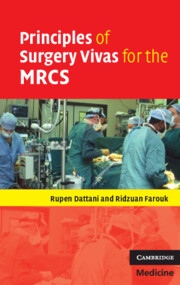Book contents
- Frontmatter
- Contents
- Acknowledgements
- Abdominal Aortic Aneurysm (AAA)
- Biopsy and Cytological Sampling
- Cancer Treatment I: Surgery
- Day Surgery
- Elderly and Surgery
- Fluid Management
- General Anaesthetics
- Head Injury
- Immune System
- Jaundice
- Laparoscopy
- Minimal Access Surgery
- Needles
- Obesity and Surgery
- Paediatric Surgery
- Radiology
- Scars
- Thyroid Surgery
- Urological Investigations I
- Wound Classification
Biopsy and Cytological Sampling
Published online by Cambridge University Press: 11 March 2010
- Frontmatter
- Contents
- Acknowledgements
- Abdominal Aortic Aneurysm (AAA)
- Biopsy and Cytological Sampling
- Cancer Treatment I: Surgery
- Day Surgery
- Elderly and Surgery
- Fluid Management
- General Anaesthetics
- Head Injury
- Immune System
- Jaundice
- Laparoscopy
- Minimal Access Surgery
- Needles
- Obesity and Surgery
- Paediatric Surgery
- Radiology
- Scars
- Thyroid Surgery
- Urological Investigations I
- Wound Classification
Summary
What is the difference between biopsy and cytology?
A biopsy is the process by which tissue is obtained for microscopic or other investigation. Diagnosis of diseases based on examination of individual cells and small clusters of cells is called cytology or cytopathology. Biopsy may be diagnostic or therapeutic, whilst cytology tests may be used for diagnosis or for screening.
What are the advantages and disadvantages of these techniques?
A cytology specimen is usually easier to obtain, causes minimal discomfort to the patient, is less likely to result in serious complications, and is cheaper than a tissue biopsy. Although, in many clinical situations, the accuracy of cytology and biopsy is the same, in some situations a biopsy result is more accurate, e.g. in the diagnosis of a follicular thyroid carcinoma. The other advantages of a biopsy are that it allows assessment of tumour invasion and in some cases an excisional biopsy may be the only treatment required.
Describe the different forms of biopsy techniques
Fine Needle Aspiration (FNA): the least invasive of the biopsy techniques and one of the first-line diagnostic procedures in the evaluation of a palpable breast mass. The procedure has the capability of being both therapeutic and diagnostic, e.g. during aspiration of a breast cyst the aspirate is often green tinged and serous (diagnostic), and aspiration should collapse the cystic cavity (therapeutic)
Core needle biopsy (CNB): involves removal of a core of deep tissue usually using a Trucutt needle. Samples obtained with CNB are often large enough to provide detailed histological and architectural information including the type and grade of the tumour, its invasiveness, as well as hormone receptor status. This is an advantage over FNA, particularly with patients who have large masses suggestive of cancer
[…]
- Type
- Chapter
- Information
- Principles of Surgery Vivas for the MRCS , pp. 32 - 49Publisher: Cambridge University PressPrint publication year: 2007



